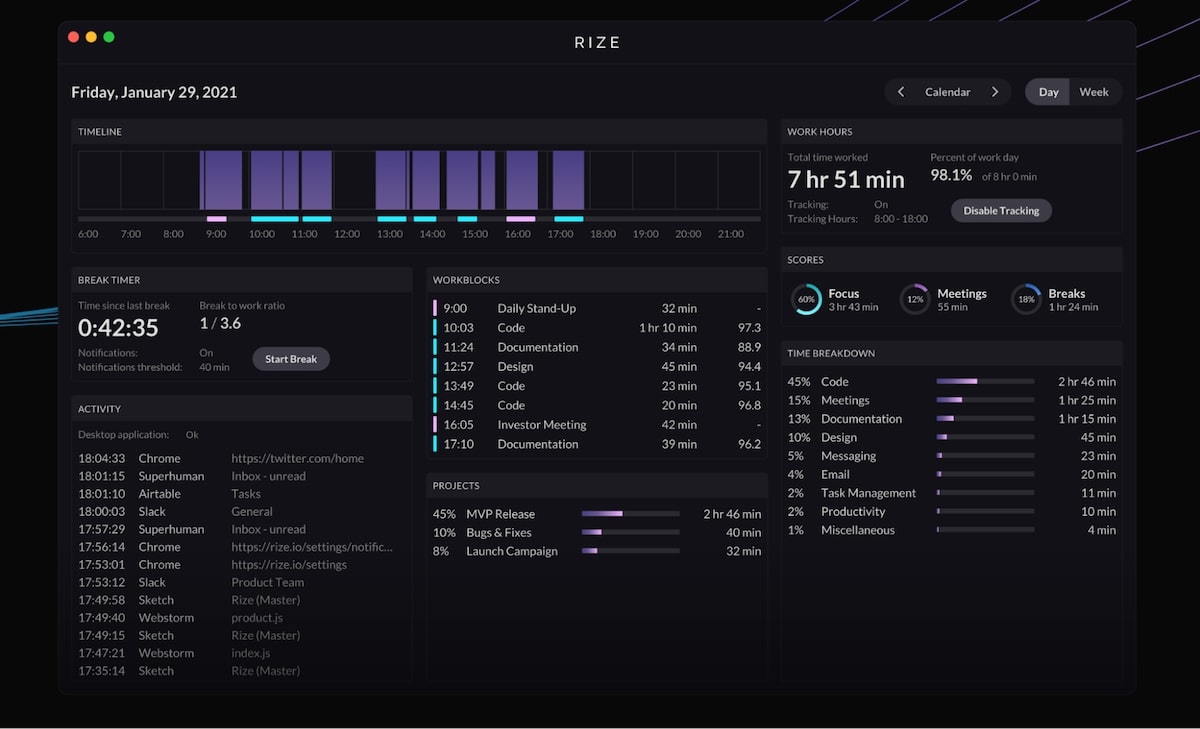Effective time management — prioritizing the tasks that make the most impact and completing each one efficiently — allows you to make the most of your workday. When you use time management techniques, you can maximize your working time, be more productive, and achieve your goals with less effort.
This article shares five time management techniques that help you stop wasting time at work and get more done each day.
What Is a Time Management Technique?
But first, what is a time management technique? How does it make you more efficient?
Time management techniques are rules around how you can organize and use your time to achieve your set goals. They help you solve the most glaring productivity issues you may be facing at work or in your personal life. For example, if you have a problem setting priorities or focusing on a single task, the Eisenhower Matrix or time blocking time management techniques may be most helpful for you.
Good time management techniques make it easier to set priorities and achieve more in less time. You also:
- Get a clearer idea of how you need to plan your work weeks to be productive
- Plan ahead, which helps you collaborate better with team members
- Overcome habits, such as procrastinating, multitasking, and giving in to quick distraction fixes like social media and messaging notifications
- Get better at time management skills, such as planning, prioritizing, setting boundaries, and delegating.
Finding the Right Time Management Techniques for You
Before choosing a time management technique, identify where your productivity gaps are. This will help you choose the best technique for you. A few common productivity problems are:
- Prioritizing: You find it hard to differentiate between important and urgent tasks on any given day.
- Procrastinating: You're often unable to motivate yourself to work or complete important tasks.
- Finding work-life balance: You're often unable to switch off from work at the end of the day or stick to regular work hours.
- Saying no: You're often unable to turn down requests and opportunities from other people to make room for what matters to you. This may lead to you feeling overwhelmed.
- Focusing: You're often unable to power through specific tasks and give your full attention to what's in front of you, even when planned ahead.
5 Time Management Techniques to Help You Maximize Productivity

Once you know what you need to change, you're one step closer to finding a solution. You can test several time management techniques and track their results within a specific timeframe to know what productivity system works best for you.
Maybe you need a stack of more than one technique to be successful. For example, you may use Eat the Frog and the Eisenhower Matrix to plan and begin each workday. Create your own personalized workflow from the time management techniques below to maximize productivity.
1. Pomodoro Technique
The Pomodoro technique by Francesco Cirillo is an excellent time management technique for people who struggle with focusing on a single task for an extended amount of time. It helps to overcome procrastination and make progress on your mid- to big-sized projects without feeling overwhelmed.
To use this technique, set a timer to break down your work into 25-minute intervals separated by five-minute breaks. After four sessions of work (i.e., two hours) reward yourself with a longer break of 30 minutes. You may choose to increase the time spent working, to stay in longer flow states, as you improve your focus over time.
2. Getting Things Done (GTD)
The Getting Things Done technique by David Allen is a useful technique for people who find it hard to manage big projects and maintain a consistent workflow. The GTD technique structures how to think through your mental clutter and helps you focus on the right tasks at the right times.
To use this technique, follow the five steps below to break big tasks into smaller steps and complete the steps to get your desired outcome. The five steps in the Getting Things Done workflow are:
- Capture: Empty your head of mental clutter by writing, charting, or capturing anything that crosses your mind.
- Clarify: Process what you’ve captured into clear action steps you can begin working on.
- Organize: Plan and schedule everything. Add dates to your calendar, invite collaborators, delegate tasks, etc.
- Review: Monitor, update, and revise your pending tasks.
- Engage: Work on your important tasks.
3. Eat That Frog
Eat That Frog is an excellent time management technique for people who struggle with procrastination or those who are busy all the time yet make no progress on their most important projects. This technique helps to relieve stress and save mental energy you may have spent dreading or avoiding a task.
Eat That Frog encourages you to start your day with your biggest tasks first. Using this technique entails picking the biggest and most challenging task on your to-do list and completing it first, so you start each day off with high output and can pace yourself and accomplish more during the rest of the day.
4. The Eisenhower Matrix
The Eisenhower Matrix is an excellent technique for people who struggle with prioritizing tasks in their daily schedule. The method helps to delineate what's important or urgent and helps you make time for tasks with the highest value or most significant contributions.
To use this technique, draw four quadrants and group your tasks using the outline below:
- Important and urgent tasks: You should complete these as quickly as possible.
- Important and not urgent tasks: You should schedule these tasks for the most optimal and convenient time to complete them.
- Not important and urgent tasks: You should delegate these tasks or handle them at a time when you’re less busy.
- Not important and not urgent tasks: You should ignore or delete these tasks from your to-do list.
5. Time Blocking
Time Blocking is a time management technique focused on creating specific time for specific tasks. This technique encourages deep work and focus and often involves task batching and timeboxing, which simply means batching similar tasks into dedicated time limits.
To use this technique, break your task list or daily schedule into time blocks for each workday. Dedicate specific time to tackle each task you’re to complete in a day. At the end of each day or the next day, review how you worked compared to what you planned, and learn to improve your performance by studying your own work patterns.
Use Rize to Discover the Best Time Management Strategies for You

Once you know what you need to change and have tested and chosen the techniques that solve your issues, the next crucial step is to find time management tools to help manage and track your efforts and implement the techniques effectively. Tracking how you spend your time gives you concrete data to know what you need to improve (or reduce) to become more productive at work. You can identify inhibitive work patterns and replace them with better strategies.
Rize, an intelligent time-tracking app, helps you maximize the use of your time at work by tracking and quantifying your work habits and routines to show where you're most productive. With real numbers showing how you spend your time, you learn more about yourself and can select the best time management techniques to enhance your productivity.
Are you ready to become more productive and intentional with your time at work? Download the Rize app to get started.
